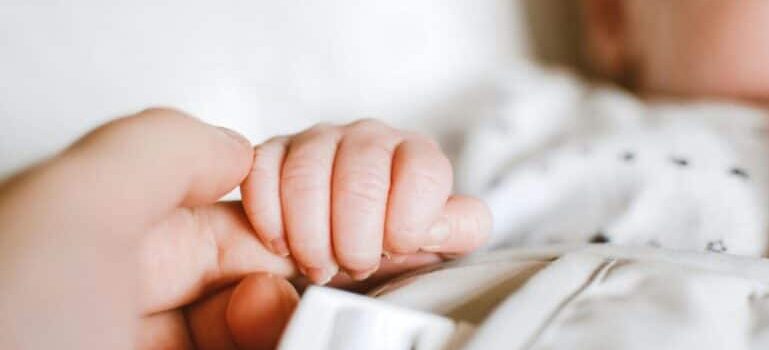Moving With a Baby Made Easy
Moving to a new home is an exciting milestone, but adding a baby into the mix can make it seem overwhelming. The good news is that with thoughtful preparation and strategic planning, the challenges of moving with a baby can be significantly reduced. Best Cross Country Movers is here to offer you practical tips and proactive steps to ensure a worry-free relocation, allowing you to focus on the joy of settling into your new home with your little one! We can also help you find the right moving company for your needs in case you need it!
Preparing for the Move
Planning a move with a baby requires careful organization and attention to detail. It’s not just about transferring belongings from one place to another; it’s about ensuring a safe, comfortable, and seamless transition for your little one. Starting early and being methodical can significantly ease the stress of moving day.

Organizing Your Move
When moving from Houston to Charlotte, or anywhere else with a baby, organizing each step of your relocation is critical to ensure everything goes easily. Effective planning minimizes the disruption to your baby’s routine and helps you manage the logistics with less stress. Here’s how to organize your move effectively:
- Importance of early planning. Starting your preparations well in advance allows you to tackle tasks gradually, reducing last-minute rushes and ensuring nothing is overlooked. This approach is especially important when moving with an infant, as it helps maintain a calm environment.
- Choosing the right moving company. If you’re moving to Miami, for example, it’s crucial to select cross country moving companies in Miami that are experienced in family relocations and known for their reliability and excellent service. Check reviews and ask for recommendations to find a mover that meets your specific needs.
- Packing strategies for efficiency. Organize your belongings by room and label boxes clearly, particularly those containing baby items. Consider packing an ‘open first’ box with essentials you’ll need immediately upon arrival to make the first hours in your new home as easy as possible.
Essential supplies checklist
Having all the necessary items for your baby easily accessible during the move can make a big difference in how your moving day goes. Here’s what you should consider adding to your checklist for a move with your baby:
- List of baby essentials. This list should include diapers, wipes, baby food, several changes of clothes, pacifiers, and favorite toys. These items will keep your baby comfortable and help maintain their routine throughout the transition.
- Packing a dedicated baby essentials bag. Keep a separate, easily accessible bag packed with all your baby’s necessities. This bag should be with you at all times during the move, ensuring you have everything you need to keep your baby comfortable and content.

Childcare During the Move
Ensuring your baby or toddler receives adequate care during the move is crucial. Proper attention not only keeps them safe but also minimizes stress for both you and your child. Strategizing childcare for moving day is essential—it allows you to concentrate on the move while feeling confident that your little one is content and well looked after. If you’re also moving with a pet, clever planning can turn a potentially chaotic situation into an advantage. For instance, allowing your child to play with the pet under supervision can keep both entertained and make the day go smoother for everyone involved.
Options for babysitting
Securing reliable childcare for the day of the move is crucial. Here are a couple of options to consider before moving from Georgia to New York, for example, with your little one:
- Family members as babysitters. Having a trusted family member like a grandparent to watch over your baby can be incredibly beneficial. They already have a bond with your child, which can make this a comforting experience for both the baby and the caretaker.
- Professional babysitting options. If family help isn’t available, consider hiring a professional babysitter. Look for someone with excellent references and experience with young children. Schedule a meet-and-greet beforehand to ensure they’re a good fit and that your baby responds well to them.
Engaging your child
Keeping your young one entertained during the move is key to a stress-free moving day. Prepare a variety of activities to keep your child entertained and engaged on moving day. For babies, this could include new or favorite toys that are easy to access. For toddlers, consider portable games, books, or a tablet loaded with educational apps and videos. This not only keeps them occupied but also helps maintain a semblance of normalcy during the upheaval of moving.
Maintaining routines
During a move from San Diego to Miami, or any other cross country move, maintaining familiar routines is crucial for your baby’s comfort and well-being. It helps minimize the stress associated with changes in their environment and schedule. Keeping feeding times consistent is vital. Even in the chaos of moving, try to feed your baby at their usual times as much as possible. This constancy is comforting to them and helps maintain a sense of normalcy. When it comes to sleep, the move might disrupt their usual sleep schedule. To help, you can subtly adjust their naps and bedtime in the days leading up to and following the move to better suit the new routine. This gradual change can ease the transition for them, making it less jarring.

Once you arrive at your new home, setting up a familiar environment for your baby should be a priority. Start with their bedroom or the area where they spend most of their time. Arrange their space with familiar items such as their usual bedding, toys, and decorations as soon as possible. This immediate familiarity can help soothe any anxiety they might feel in a new place and encourage an easier adjustment to their new surroundings.
Transportation Tips When Moving With a Baby
Traveling with a baby, whether by car or plane, requires careful planning and preparation to ensure their safety and comfort throughout the journey. Here’s how to manage both modes of transport effectively.
Traveling by car
We will take as example, moving from San Diego to Sacramento and traveling by car. When traveling by car, safety is paramount. Make sure your car seat is properly installed according to the manufacturer’s instructions and appropriate for your child’s age and size. Plan for regular stops to give your baby a break from the car seat, allowing them to stretch and you to tend to their needs, such as diaper changes and feeding. Keeping your baby comfortable and entertained during the drive is also essential. Adjust the car’s climate control to maintain a comfortable temperature and consider sunshades for the windows to protect them from direct sunlight. Bring along a mix of toys and perhaps some soothing music to help keep them calm and engaged during the journey.
Traveling by plane
Flying with a baby involves additional considerations, starting with understanding the airline’s regulations regarding infant travel. Most airlines provide detailed guidance on what you need to bring and how to secure your baby during the flight, whether it’s with an infant seat belt or a car seat. Before your trip, check with your airline about facilities and accommodations for babies, such as priority boarding and the availability of bassinets. Pack essential items for a multifamily move with a baby in your carry-on, including diapers, wipes, food, and a few favorite toys to keep your baby content. It’s also a good idea to feed your baby during takeoff and landing to help equalize their ear pressure and reduce discomfort.
Setting Up the New Home
Once you arrive at your new home, setting up a safe and welcoming environment for your baby is crucial. It’s important to prioritize their comfort to help them adjust easily to the new surroundings.

Prioritizing your baby’s space
The first area you should set up in your new home is your baby’s nursery. Having a designated space for your baby will help them feel secure and assist in maintaining their routine. Immediately arrange the nursery with their crib, changing station, and familiar items like blankets and toys. This familiar setup will help your baby adapt more quickly to the new environment. If the full setup of the nursery is delayed, consider temporary solutions. You can use a portable crib or a bassinet in your bedroom or another safe area of your home. Ensure that the temporary space has all the essentials your baby needs, such as diapers, wipes, and extra clothes.
Safety measures
Childproofing your new home is essential to creating a safe space for your baby to explore. Start by securing cabinets and drawers, covering electrical outlets, and ensuring that no small objects are within reach. Install safety gates at the top and bottom of stairs, and ensure windows are secure. Perform thorough safety checks after, for example, moving from Texas to Nevada. Inspect the house for potential hazards such as loose carpeting or tiles, sharp edges on counters or furniture, and accessible cords from blinds or appliances. Addressing these issues immediately can prevent accidents and help ensure your baby’s safety as they become familiar with the new home.
Adjusting to the New Environment After Moving With a Baby
Relocating to a new home also means adapting to a new environment, which can be a significant transition for both you and your baby. Making sure that healthcare is in place and helping your baby acclimate socially and environmentally are key steps in this adjustment process.
Healthcare arrangements
One of the first tasks after moving is to find a new pediatrician. This is crucial as you will need a trusted healthcare professional to oversee your baby’s growth and any potential health issues that arise. Start by researching pediatricians in your area, checking their reviews, and asking for recommendations from new neighbors or local family groups. Once you select a pediatrician, schedule a check-up as soon as possible to establish a relationship and ensure your baby is in good health following the move.

Social adjustments
Adjusting to new social environments is equally important for your baby’s development. If your new home is in a significantly different climate, it will be important to gradually acclimatize your baby. This may involve adjusting their clothing and daily routines to suit warmer or colder conditions. Introduce your baby to the new surroundings gently. Take regular walks to familiarize them with the neighborhood. If possible, find local parent groups or baby classes. These can be excellent ways for both you and your baby to make friends and integrate into the community. Engaging with others in similar situations can provide social support for you and developmental benefits for your baby.
Coping with Stress After Moving With a Baby
Moving with a baby can be a stressful experience, impacting both your emotional and physical well-being. It’s essential to manage this stress effectively so that you can be fully present and supportive of your baby during this relocation.
Parental self-care
Taking care of yourself is not just beneficial; it’s necessary. Ensure you’re taking regular breaks throughout the moving process to rest and recuperate. Managing stress can involve simple activities like reading, taking a walk, or practicing mindfulness and meditation. It’s also important to maintain a healthy diet and get adequate sleep, as these factors significantly affect your ability to handle stress.
Support systems
Having a strong support system can greatly ease the stress of moving from San Francisco to Las Vegas or anywhere else. Lean on both new acquaintances in your new community and old friends or family, even if it’s just for emotional support over the phone. Don’t hesitate to ask for help when you need it—whether it’s someone to watch your baby for an hour, help with unpacking, or just have a friendly chat.
Engage with community resources, such as local parenting groups or community centers, which can offer support and advice. These connections can be invaluable as you navigate your new environment and can help reduce the feeling of isolation that sometimes comes with a big move. By leveraging these support systems, you can ease the burden of the move and find comfort in the shared experiences of others.
Celebrating Milestones
Moving is a marathon, not a sprint, and every little success is a step towards settling into your new home. It’s important to acknowledge these achievements because they reflect your hard work and planning. Whether you’ve just managed to neatly box up the living room or finally found the perfect layout for your baby’s new nursery, these milestones matter. Each box ticked off your to-do list is a victory, so give yourself a pat on the back! Celebrating these moments can uplift your spirits and motivate everyone involved to keep pushing forward.
In the whirlwind of packing tapes, boxes, and moving trucks, it’s easy to miss out on the emotional significance of leaving a home and starting anew. Make it a point to turn these transitions into joyful experiences. Why not take a playful snapshot of your baby in the pile of moving boxes, or record the moment when you all step into your new home together? Or maybe you can capture your toddler’s amazed expression as they explore the new backyard. These are more than just pictures or videos—they’re precious memories that will tell the story of this big family adventure for years to come. By focusing on creating these happy memories, you can turn the stress of moving into a series of joyful moments that celebrate your family’s journey.
Establishing New Routines After Moving With a Baby
After the move, finding your new normal is essential for both you and your baby. Begin by gradually reintroducing familiar routines from your previous home. Regular meal times, consistent bedtime rituals, and predictable playtimes help create a stable environment for your baby. This consistency is comforting and can significantly ease the transition to a new space. If you used to read a story before bed or have a little dance party after breakfast, keep those traditions going. These familiar activities are not just fun—they’re reassuring and help your baby understand that some things will stay the same, even in a new home.

Moving to a new area is a chance to discover new places and make new memories. Take walks or short drives with your baby to explore your new neighborhood. Find local parks where your baby can see other children play and maybe even make new friends. Libraries often have story times and other baby-friendly activities where you could both meet neighbors and learn about community resources. Each outing is a chance for your baby to see, hear, and touch new things, stimulating their senses and encouraging developmental growth. Plus, these explorations can help you feel more connected to your new community, making it feel more like home for your entire family.
Long-Term Adjustments
As you settle into your new home after, for example, moving from Florida to South Carolina, it’s important to observe how your baby adapts to the changes. Watch for their reactions to the new environment—do they seem more fussy or unusually quiet? Are they sleeping and eating as usual, or have those patterns shifted? These observations can tell you a lot about how comfortable they are feeling. Pay attention to these cues and be prepared to adjust routines to better accommodate their needs. For instance, if your baby is having trouble sleeping through the night in the new space, consider adding more comforting bedtime rituals or rearranging the nursery to make it feel more secure and familiar.
Just as your baby grows and develops, so too should your approach to managing your home and daily life. Stay adaptable and responsive to the changing needs of your growing child. For example, as your baby starts crawling or walking, you might need to update your childproofing strategies to keep up with their newfound mobility. The nursery may require a transformation into a toddler-friendly room with appropriate furniture and safe play areas. Also, consider introducing new activities that align with developmental milestones, such as sensory play for infants or more complex puzzles for toddlers. These adjustments ensure that your home continues to be a supportive and nurturing environment for your child’s growth and happiness.
Your Guide to a Joyful Move with Your Baby!
Remember that moving with a baby can be a easy and positive experience with the right preparation and mindset. As you start this new chapter, take the time to plan carefully, celebrate small victories, and establish comforting routines for your baby. We hope these tips will guide you through a stress-free move. If you are ready to start planning your move, contact us today and set the stage for your family’s next great adventure as soon as possible. Let’s make your new beginning a happy and well-organized one!





